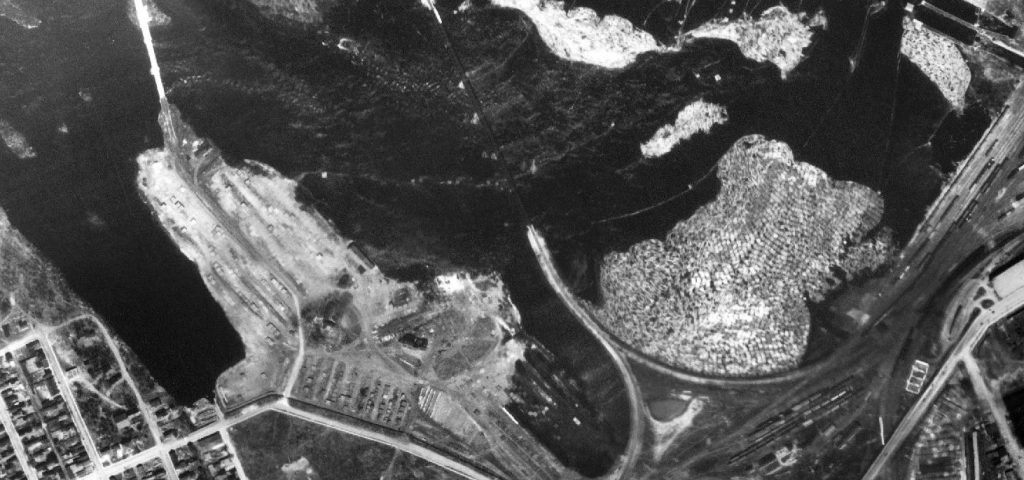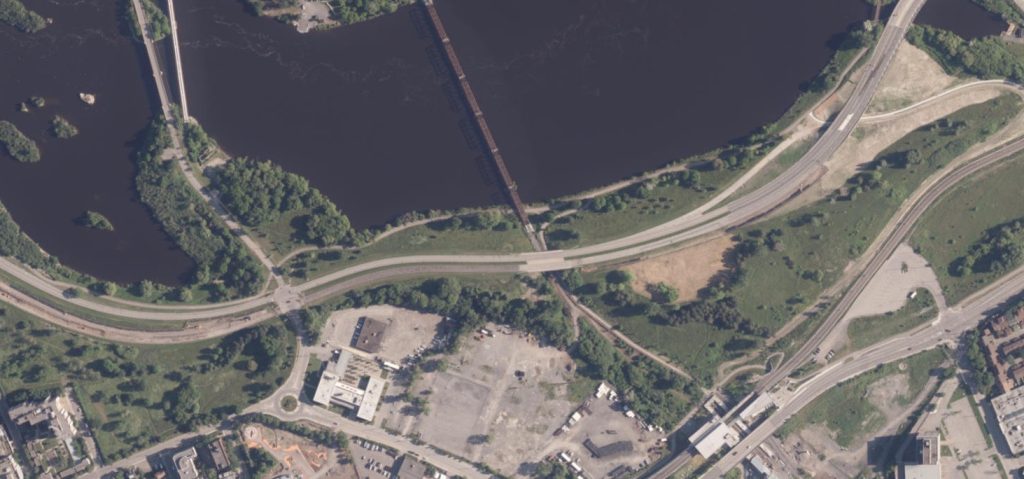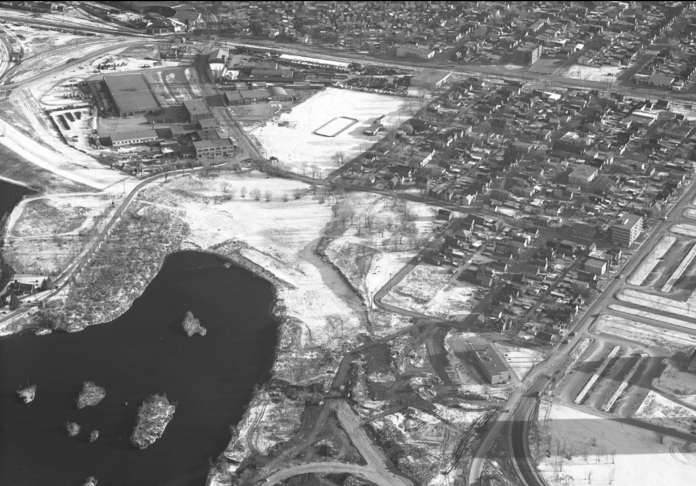By Dave Allston
The creation of landfill along the Ottawa River, and the subsequent construction of the Parkway along the shoreline in the 1960s, was an ambitious project that forever changed the west end.
In many ways, it was a curse to residents of riverside communities like Westboro and Champlain Park, who were suddenly cut off from the River around which they were built. In Mechanicsville’s case, Lazy Bay being filled in to allow for a straighter run of the Parkway likely saved the neighbourhood.
At the time, the city was implementing urban renewal projects in many of its poorer areas. Mechanicsville was high on the hit list and many options were considered, including the leveling of the entire neighbourhood.
Like LeBreton Flats, one scenario could have seen all of the houses in Mechanicsville demolished and replaced by blocks of 12-storey apartment buildings set within parkland.
The filling of Lazy Bay, Bayview Bay and Nepean Bay occurred throughout 1963. Once they reached capacity in February 1964, the first thing the City did was hold a party there. The 1964 Ottawa Winter Carnival included events all around the vicinity of Nepean Bay, including a square dance party and Carnival Queen contest at the newly opened City Centre warehouse.
As part of the festivities, the city held their annual “Burning of the Greens” on the new Nepean Bay landfill, where all of the Christmas trees collected by the city were stacked and burned in a large public spectacle. The event, however, was a failure.
Poor weather led to a sparse turnout, and the trees failed to ignite thanks to a recent covering of five inches of snow. Staff used “judicious amounts of flammable fluid” to try to get it going, but the blaze was “disappointingly unspectacular” according to the Ottawa Citizen.
The Parkway west of Parkdale had opened in December of 1963. That portion had been easy. The section from Parkdale to downtown had much more work ahead.
When spring arrived in 1964, the NCC’s next step was to convert the trash-filled bays into usable land. Delays led to these areas sitting largely untouched throughout the spring and summer, becoming a popular spot for seagulls. The Citizen referred to Nepean Bay as a “fly-in restaurant.”
The NCC’s approved budget in the House of Commons for 1964-65 included plans for the parkway construction across the new causeways at Lazy Bay and Bayview Bay, as well as construction of a parkway overpass of the CPR railway tracks near the now-named Chief William Commanda Bridge.
That summer, the NCC put out two tenders for the parkway construction of the two bay sections. Interestingly, both included requirements of the excavation of garbage as part of the contracts.
A total of 100,000 cubic yards was to be removed from the Bayview section, and 19,000 cubic yards from Lazy Bay. This amount of refuse sounds especially significant when you consider that a dump truck had a capacity of about 10 cubic yards — meaning roughly 11,900 truckloads of waste was required to be removed from the bays.
Testing at the time showed that the garbage in Lazy and Bayview Bays was deemed to be of “low shear strength and subject to settle considerably under load,” creating concerns for foundation stability. A total excavation under the future road surface was required to avoid the risk of irregular settlement over the coming decades. Rock fill would replace it. The garbage could be left where only earth cover would be required.
L. J. Corkery Ltd. was awarded the Bayview contract for $371,969, while the Gordon S. Mulligan Company won the Lazy Bay contract for $98,126. Mulligan was tasked with the excavation work, construction of 1,100 feet of parkway, and some sewer installations for the parkway portion just north of Mechanicsville.

Two backhoes arrived on Aug. 2, and began working along the shoreline and loading the muck into trucks. Work also began on some drilling and blasting along the sides of Lazy Bay, and the completion of the causeway across the bays.
The first quantities of rock cover for the landfill began to arrive that fall when the NCC trucked out rock and rubble from yet another major project occurring concurrently, the $3.5 million burial of the CPR Prescott Line in a series of deep cuts, underpasses and a tunnel along the tracks from Bayview to Carleton University, known today as the O-Train Trillium Line.
Gordon Mulligan passed away in 2002, but his daughter Holly Reed specifically remembered that her father was involved in removing rock from the CPR line near Preston and Somerset.
“Another company had the job of blasting the rock, and then his company was in charge of taking the rock out. The rubble that came out of there was probably used on the Parkway,” she recalled.
As for the waste being removed from the bays, 44,500 cubic yards of it was pulled out and relocated from one spot over to the south slope of the Bayview Bay, west of the bridge. Earth fill was then added on top, as well as 1,000 gallons of an “odor control agent solution.” Even more of the excavated waste was hauled across the CPR tracks and dumped into the Nepean Bay landfill, which remained stagnant.

The biggest excavation in Canadian history
Meanwhile, yet another major capital project played a critical role in the development of the landfill areas. In the fall of 1964, it was announced that “the biggest excavation job undertaken in the middle of any city in Canadian history” was about to occur in downtown Ottawa where a $1,283,000 hole would be dug in the centre of Ottawa to make way for the new National Arts Centre.
It was stated that all of the material removed from the NAC site would be trucked west to the new landfill site along the River. The rock would be used to complete the Nepean Bay causeway on which the roadway would be built, while earth was placed on top of the landfill to compress the garbage and create a subgrade layer upon which landscaping could finish what would become new usable land.
Excavation for the NAC began in February of 1965. At its peak, 37 trucks were being used to carry the fill away to LeBreton Flats, each making three trips an hour. By project completion in August, 90,000 pounds of dynamite had been used for more than 1,500 blasts, and 540,000 tons of excavated material had been removed from the NAC property. A total of 1.5 million yards of fill was used on Nepean Bay.
Work on the Parkway continued through various delays and challenges until finally opening all the way to Wellington Street downtown on July 7, 1967, the completion of a $12 million project that took more than 20 years to come to fruition.
Much of this man-made land along Nepean Bay through to Lazy Bay still awaits its purpose. Today, a large portion of the proposed “Embassy Row” in Mechanicsville is on this land; and most of the proposed “parks district” in the LeBreton Flats Master Concept Plan is also located there. It includes an “urban beach” which incredibly harkens back to the Federal District Commission’s very first plan for this space.
Nearly 60 years after the land was created, the debate continues, just as it does for the streets of old LeBreton Flats. Whatever they choose to do, they’ll have to be careful about what they might find when digging down for basements and parking garages.
